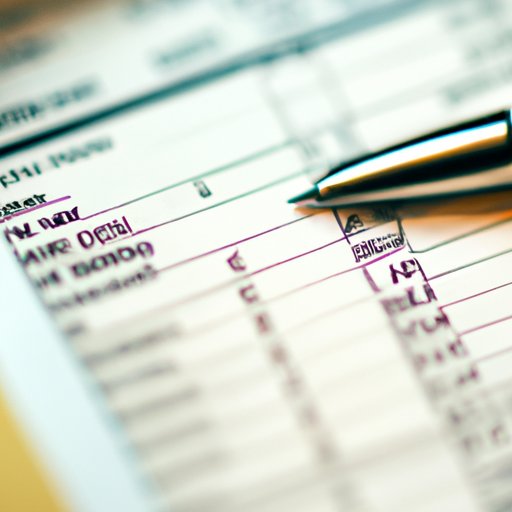
Introduction
Imagine having a financial emergency, such as an unexpected car repair or medical bill, only to find out that you have insufficient funds in your checking account. Or, on the other hand, keeping too much money in your checking account can result in missed investment opportunities and lost potential returns. It can be challenging to know how much money you should keep in your checking account. This article aims to provide you with tips and strategies to help you determine your ideal checking account balance.
Why it’s Important to Know How Much Money You Should Keep in Your Checking Account
First and foremost, knowing your ideal checking account balance helps you achieve financial stability and peace of mind. When you have enough money to cover your monthly expenses, you can avoid overdraft fees, credit card debt, and other financial pitfalls. On the other hand, keeping too much money in your checking account means missing out on investment opportunities, which can hinder long-term financial growth.
The Pros and Cons of Keeping a Larger or Smaller Balance in Your Checking Account
So, should you keep a larger or smaller balance in your checking account? Here are some advantages and disadvantages of both:
Advantages of Maintaining a Larger Balance in Your Checking Account
- Provides a buffer against unexpected expenses or loss of income
- Offers a sense of financial security and peace of mind
- Ensures enough funds are available to cover large purchases or bills
Disadvantages of Maintaining a Larger Balance in Your Checking Account
- Missed investment opportunities due to lost potential returns
- May be subject to low or no interest on the excess funds
- May be more tempting to overspend or not budget effectively
Advantages of Keeping a Smaller Balance in Your Checking Account
- Optimizes the potential returns on investments
- Discourages overspending and encourages effective budgeting
- May be subject to higher interest rates on excess funds in savings accounts
Disadvantages of Keeping a Smaller Balance in Your Checking Account
- May be subject to overdraft fees and other financial pitfalls
- May lead to increased stress and financial insecurity
- May not have enough funds available to cover unexpected expenses or large bills
How to Calculate your Monthly Expenses and Determine Your Ideal Checking Account Balance
The first step in determining your ideal checking account balance is to calculate your monthly expenses. Here is a step-by-step guide:
- List all of your monthly bills and expenses, including rent/mortgage, utilities, groceries, transportation, insurance, and any other fixed expenses
- Estimate your variable expenses, such as entertainment, dining out, and shopping
- Add up all of your bills and expenses to determine your total monthly expenses
Once you have calculated your monthly expenses, you can determine the minimum balance needed to cover those expenses. It is generally recommended to keep a minimum of one month’s expenses in your checking account. However, if you have a volatile income or have irregular expenses, you may want to keep a larger buffer in your checking account.
It is essential to adjust your checking account balance based on changes in income and expenses. For example, if you receive a raise, you may want to start investing more and adjust your checking account balance accordingly. Conversely, if your expenses increase, you may need to readjust your checking account balance to ensure you have enough funds to cover your bills.
Tips for Managing Your Checking Account Balance to Avoid Overdraft Fees
Overdraft fees can be a significant financial burden and can quickly add up. Here are some practical tips for managing your checking account balance and avoiding overdraft fees:
- Set up automatic alerts to notify you when your balance drops below a certain threshold
- Balance your checkbook regularly to make sure your transactions are accurate and up to date
- Monitor your account regularly to ensure there are no fraudulent or unauthorized transactions
How to Invest Your Excess Cash Instead of Keeping it in Your Checking Account
If you have excess cash that you don’t need in your checking account, you may want to consider investing it to earn potential higher returns. Here are some investment options:
Savings Accounts
Savings accounts offer competitive interest rates and are a safe and reliable investment option. They are FDIC-insured, which means your money is protected up to $250,000 per account. However, savings accounts have relatively low interest rates and may not be the best investment option for long-term goals.
Certificates of Deposit (CDs)
CDs offer higher interest rates than savings accounts and are a safe and reliable investment option. However, CDs come with penalties for early withdrawals, which can make it challenging to access your funds when you need them.
Mutual Funds
Mutual funds offer diversification and professional management to investors. They can offer higher potential returns than savings accounts and CDs, but also come with higher risks. It is essential to do your research and carefully consider the mutual fund’s track record and management fees before investing.
Conclusion
Determining your ideal checking account balance is crucial for financial stability, peace of mind, and long-term financial growth. It is essential to balance your checking account based on your income, expenses, and financial goals. By following the tips and strategies outlined in this article, you can manage your checking account balance more effectively and avoid costly financial pitfalls.




